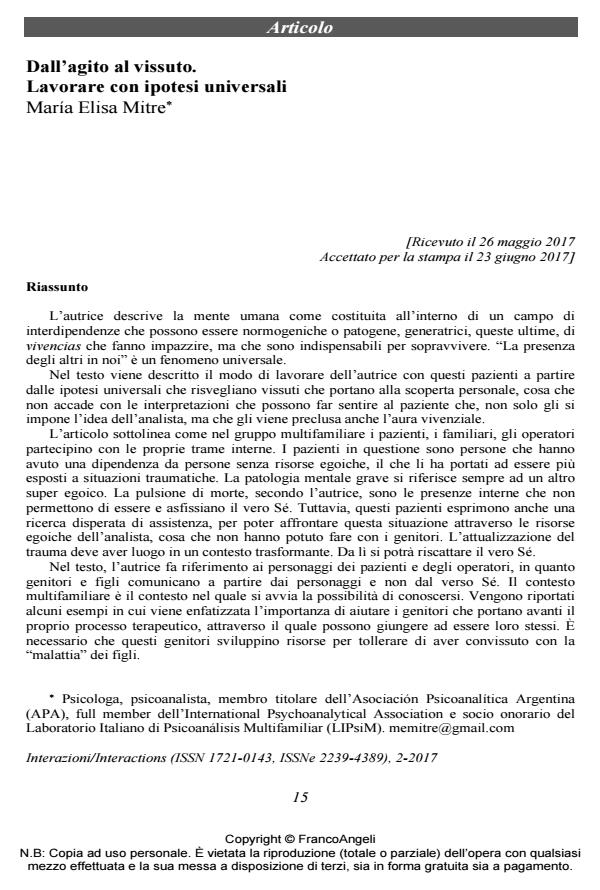From the act to the experience. Working with universal hypotheses
Journal title INTERAZIONI
Author/s María Elisa Mitre
Publishing Year 2017 Issue 2017/2 Language Italian
Pages 13 P. 15-27 File size 163 KB
DOI 10.3280/INT2017-002002
DOI is like a bar code for intellectual property: to have more infomation
click here
Below, you can see the article first page
If you want to buy this article in PDF format, you can do it, following the instructions to buy download credits

FrancoAngeli is member of Publishers International Linking Association, Inc (PILA), a not-for-profit association which run the CrossRef service enabling links to and from online scholarly content.
The author explains that the human mind is constituted by a field of interdependencies that may be either normogenic or pathogenic, generating, the latter, maddening experiences in spite of being indispensable to survive. "The presence of others in ourselves" is a universal phenomenon. The text describes how the author works with patiens, using universal hypotheses. They awake experiences which lead to the persons own discoveries. This does not happen with an interpretation, which can make the patient feel not only that the idea of analyst is imposed, but also can obturate the experiential halo. The article emphasizes that the multifamily group patients, relatives and professionals, assist with their own internal plots. Patients depended on people without ego resources, who led them to be more exposed to traumatic situations. Severe mental pathology is always refered to another person with super-ego characteris-tics. The death drive, in the opinion of the author are the internal presences that do not allow us to be, and suffocate our true self. It is also a desperate search for assistance to be able to face this situation with the analyst’s ego resources, as they could not do with their parents. The trauma update must take place in a transformer context. From there you can rescue the true self. The author refers to the characters of both the patients and the professionals. Sons and parents communicate from the characters instead of doing it from the true self. It is in the multifamily context where they have the opportunity to meet. The text presents examples emphasizing how important it is to help parents to carry out their own therpeutic process, which alows them to become themselves. It is necessary for them to develop resources to be able to tolerate the idea of having had something to do eith their sons "sickness". The dialogues transcribed in this text reveal a specific way of working with difficult patients. In a genuine way, the author uses an example in which herself is involved to explain how she felt rescued by a patient and thus changed the atmosphere of a group that, until that moment, had only been a dialogue between characters. The intervention of the author was made from her healthy potential, which had been suffocated in her own maddening plot until that precise moment. It was promoted by what she perceived as an unconscious "harassment" towards the patient by a professional. Then different emotional experiences began to emerge in each one of the patients, from their true self. The characters of professionals disappeared. In this way t the external and internal atmosphere could be changed by all of them.
Keywords: Pathogenic interdependences, normogenic interdependences, universal hypotheses, character, healthy potential, emotional experience.
- Badaracco J.G. (2006). La nueva mandar di pensar. Inedito.
- Ferenczi S. (1932). Sin simpatía no hay curación. El diario clínico de 1932. Buenos Aires: Amorrortu Editores, 1997.
- Freud S. (1937). Analisi terminabile e interminabile. OSF, vol. 11. Torino: Bollati Boringhieri.
- Winnicott D.W. (1971). Gioco e realtà. Roma: Armando.
- Il tema di Lara. I disturbi dissociativi. Un percorso di integrazione tra psicoterapia individuale e gruppo di Psicoanalisi Multifamiliare Mariantonietta Masia, in INTERAZIONI 1/2022 pp.68
DOI: 10.3280/INT2022-001009
María Elisa Mitre, Dall’agito al vissuto. Lavorare con ipotesi universali in "INTERAZIONI" 2/2017, pp 15-27, DOI: 10.3280/INT2017-002002